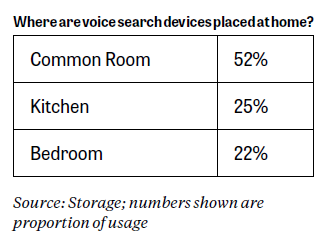 A quick look at some recent data and you know voice search is set to dramatically change how businesses are looking at their digital marketing and search engine optimisation (SEO) strategy.
A quick look at some recent data and you know voice search is set to dramatically change how businesses are looking at their digital marketing and search engine optimisation (SEO) strategy.
By 2020, voice searches are expected to make up more than 50 per cent of all searches. Sales and adoption of leading voice search devices such as Google Home, Amazon Echo (Alexa), Google Assistant, iPhone (Siri), Android Phones and Microsoft Cortana have grown exponentially. User behaviour, too, is changing rapidly to adopt voice search technology.
So, what’s propelling user behaviour to change from text search to voice search?
Convenience: We type at approximately 40 words a minute for text searches, while we speak to voice search devices at 150 words a minute.
Natural language: In text search we have to use a string of set keywords, whereas voice lets us use conversational language. Superior user experience: Text returns a clutter of multiple links that the user must sift through; voice returns a relevant and sharp result.
Supports continuous tasking: You can voice-search a recipe while cooking, or search for a restaurant near you while driving.
Overall, the evolution of smart homes and screenless devices, smaller phone screens and shorter human attention spans are factors in voice search fast becoming an integral part of our day-to-day life.
 When do people use voice search?
When do people use voice search?
Studies show that a majority of users choose voice search while driving. While this should be unsurprising, since a text search is not preferable while driving, the pie chart pictured should also serve as an indicator of why voice search is gaining popularity: 

How should businesses leverage voice search?
You spent months optimising your keywords to appear among the top 10 links on Google. In reality, more than 56 per cent of searches are zero-click, and the click-through rate (CTR) for your brand –even when you are ranked right on top – is usually in a single-digit percentage.
By contrast, the advantage of voice search beats every SEO result you have ever generated.
For starters, optimise your website and content for voice search. Getting a first-mover advantage in your sector is important because it won’t be long before other brands start optimising for, say, the most asked questions relevant to your business.
Voice search enables you to be the only result. When a user voice-searches an answer, he or she won’t need to go through a list of results to manually pick the one that’s most applicable. Imagine it is your brand that is facilitating that answer. It will not only improve the discoverability of your business or brand, but also put you in a position of leadership for your category.
Interestingly, most voice searches are triggered by a combination of just 25 keywords. The top few among them include how, what, best, where, can, easy, and when.
What should your content strategy be to ace voice search?
Users’ search patterns create interesting micro-moments for you to present your brand contextually. The main objective of a user when querying is called search intent, and falls under one of the following four categories:
Research: I want to know. (Which banks offer the best exchange rate?)
Explore, explore near me: I want to go. (Where is my nearest hypermarket?)
Learn: I want to do. (How best can I take care of my skin?)
Buy: I want to buy (Where can I buy an iPhone11?)
So your content should include FAQs, how-to guides, product information, buying guides and so on. Find the most searched questions related to your business, and create actionable, relevant and conversational content to address those questions. Conversational and simple are the keywords.
Serving navigational intent can be an incredible opportunity for brick-and-mortar businesses. Given that a significant number of voice searches are used to get directions, integration of local listings with voice search can help drive valuable footfalls.
Use of “long-tail keywords” for targeting can be an effective strategy to achieve relevance as well as ranking. Long-tail keywords, as the name suggests, are longer keywords than regular search queries. The trick to targeting the right long-tail keywords is to look at what conversational phrases or questions users are likely to employ in their voice search for your business.
For a successful voice search strategy, it is important to understand why a user will turn to voice search. Then you can create a great user experience through the right answers.
The next time you wonder if voice search is relevant for your business, ask yourself: “What am I losing in my business by not appearing in more than 50 per cent of a user’s searches?” And that percentage is going to grow.









